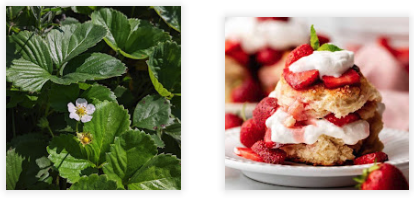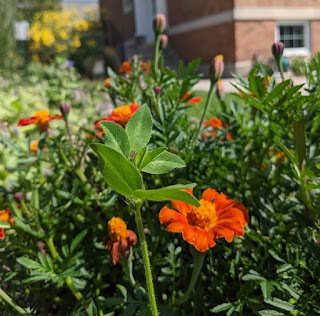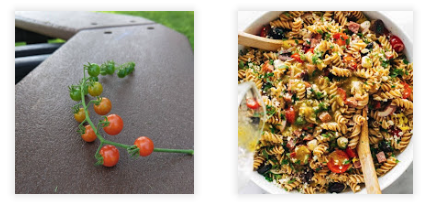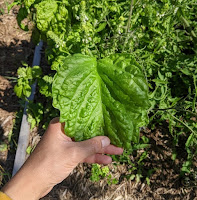
In this special blog post, our Community Relations Coordinator Shelby walks us through the sensory and vegetable garden beds near the South Lawn of the Library. Learn about the plants she and Librarian Loni are growing in the gardens, as well as some great garden-inspired recipes to try!
It's that wonderful time of year when our gardens are bushy, lively, and full of beautiful colors and flavors-- and that includes the gardens at Cromaine! Librarian Loni and I have worked hard this year to bring flowers, herbs, fruits, and vegetables to life in the garden beds near the South Lawn. Despite a very hot spring, bunny visitors, and other minor issues, we're both proud and excited about the progress of our sensory and vegetable gardens. This is a time of year to enjoy the chaos bounty of our gardens, and to enjoy recipes that highlight the very best flavors of our fresh produce! Let's have a look at the Library gardens to explore the variety of plants growing there, along with some of the wonderful recipes that they can create!
The garden bed closest to the 1927 Library entrance contains various flowers and lots of strawberry plants! Strawberries are a wonderful perennial that return each spring with beautiful, deep green leaves and delicate white flowers. These flowers produce the delicious berries that many of us have come to love each spring. Unfortunately, strawberries tend to stop blooming by midsummer, so you'll have to save our recipe recommendation for next spring. We suggest using a fresh strawberry harvest to make your very own strawberry shortcakes! The combination of fresh fruit with homemade biscuits and light whipped cream make for a great springtime treat.

The middle garden bed has hosted vegetables such as tomatoes, peppers, and other plants in the past. These "heavy feeding" vegetable plants require more nutrients than other garden plants, such as nitrogen, and can leave the soil depleted after growing in the same location over and over again. Because of this, we decided to make this garden bed a "soil reparation" zone this year, planting flowers and vegetables that help restore depleted soil. Sunflowers are known to break through and aerate the soil with their large taproots, and can absorb and store toxins found in the soil. Legumes, such as peas, bush beans, prairie clover, and lupines, are nitrogen-fixing plants, which means that they can convert atmospheric nitrogen into a form of nitrogen that other plants can use as well. Marigolds, also planted in this bed, can repel nematodes in the soil and are great for composting because they add valuable nutrients to the soil as they decompose.

Prairie clover is a nitrogen-fixing plant, and marigolds help feed the soil.
The biggest plant in this garden features large, light green leaves and an explosion of purple, star-shaped flowers. This beautiful plant is called borage! Borage is a dynamic accumulator, meaning that it mines nutrients from the soil to store in its leaves. Composting or mulching with borage leaves is a great way to return nutrients to the soil. Plus, the leaves and flowers of borage plants are edible, and add a light, cucumber-like flavor to teas, jellies, salads, and more. I highly recommend making borage jelly! This fun, simple jelly recipe is great with aged cheese and crackers, or served on cucumber tea sandwiches.

The third raised bed is our salsa garden, containing various tomatoes, herbs, and peppers. We really had fun choosing unique cultivars for this garden bed, such as giant lettuce-leaf basil, Brad's atomic grape tomatoes, and more! Have you seen the tiny, pea-sized tomatoes growing on a giant tomato plant? This variety is called spoon tomatoes, and make a wonderful addition to a summer pasta salad because the tomatoes are super sweet and don't need to be chopped.

The giant lettuce-leaf basil plants are also growing beautifully, featuring huge, aromatic leaves. These can be used for simple pesto recipes, your favorite pasta dish, or even as a wrap for your favorite meats, cheeses, or veggies!

If you look closely in this garden bed, you may also see tiny tomato plants with bright orange fruit. This variety is called orange hat, and is a wonderfully unique variety because these tomato plants need very little space, but produce lots of sweet fruit. Be sure to look for them when you visit the Library!
We also have beautiful China jade cucumbers growing on a teepee behind the garden beds, along with nasturtium. Nasturtiums are an excellent garden companion for many vegetables, and work well with cucumbers and other squash plants because they repel cucumber beetles. Nasturtiums are also an edible plant: their leaves and flowers have a spicy, peppery taste, while the flowers have a more mild and floral flavor than the leaves. I love stuffing the flowers with a little cream cheese and dill, making a pretty little appetizer or garden snack.

There are many other flowers, vegetables, and herbs to explore in the gardens-- enjoy a walk through the Cromaine gardens next time you visit the Library to learn about all of the plants we're growing this year! Plus, walk through the native gardens, managed by the Hartland Home and Garden Club, and learn about each native plant by scanning the QR codes provided on the Plant ID signs posted throughout the gardens.
Plus, gardeners won't want to miss our upcoming Seed Saving for Beginners class on Wednesday, August 21 @ 6:30 pm! Join us to learn the basic techniques for saving common vegetables and flowers, and help this year's garden contribute to next year's bounty.
We can't wait to see you at the Library soon!